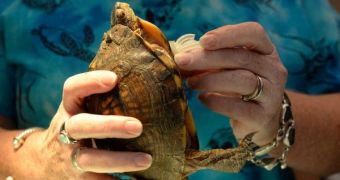Being crippled is a bad way to end up, and you don't really need to suffer something like it in order to know that. This reality holds for all living things, not just humans. Even turtles. Fortunately, at least one turtle has received a replacement for its stump.
Calling a turtle “Stumpy” might not be the most polite of choices, even when it's done as a term of endearment, but it was undeniably appropriate for the 12-year-old box turtle that we're going to talk about.
Stumpy is a 12-year-old turtle that arrived at the Oatland Island Wildlife Center in Savannah, Georgia, back in September.
It was very badly injured on its front leg, so badly in fact that Veterinarian Lesley Mailler had to amputate the whole thing.
Without the surgery, the turtle would have surely died. However, few are the animals that can survive after being in any way crippled, and while living in a controlled environment removed most of the danger, it didn't change the fact that Stumpy was in for some difficult years.
As with many things lately, 3D printing was the solution
Mailler wanted to make a prosthetic for stumpy right away, and eventually laid eyes, while at home, on a Lego wheel prosthetic, then remembered that his daughter had mentioned her school getting a 3D printer.
After speaking with the teachers there, it was agreed that a prosthetic leg for the injured turtle would become the next big fifth grade class project.
Mailler’s daughter Kaylee, along with Jake Gilluly, Matthew Brimblecom, David Richbourg, Isabel Duke and Emily Goldstein, were instructed by Teacher Raegan Dillon in producing said leg.
First the children were taught about box turtles, how they're built, how they move, that sort of thing. Then they had to design a leg which needed to possess two essential qualities.
First, it would need to fit right and be just high enough for the bottom of Stumpy's shell (the plastron) to stay off the ground.
Secondly, the hinge had to bend “naturally,” since the plastron itself bends when the turtle retreats fully into the shell.
After agreeing on a main design (which took quite a few lunch breaks and after-school meetings), the students used 3DTin (an online 3D modeling web application) to create it.
One month and 15 prototypes later, they finally printed the final version and went with Mailler to the Oatland's vet clinic to see it attached to Stumpy. While it was too tall initially, Mailler got rid of a holster and attached the ball caster straight to the leg. Mailler also used a rotary tool to sculpt out a fit on the base, since it was too flat compared to the turtle's chest.
Stumpy's new life expectancy
With how hard the animal could get around before, the vets didn't think it could live for long. Now, though, it might last 20-30 years in captivity.

 14 DAY TRIAL //
14 DAY TRIAL // 